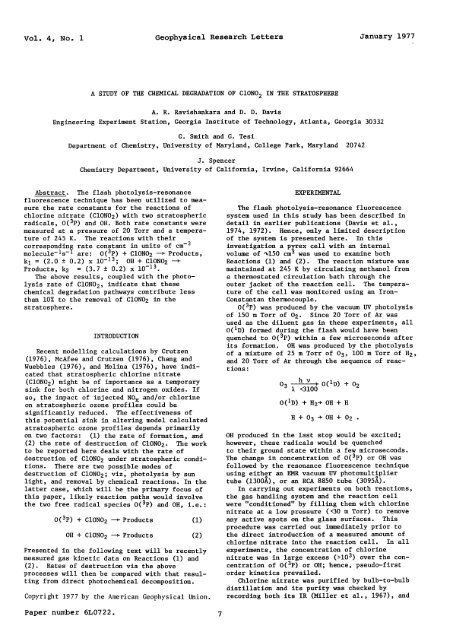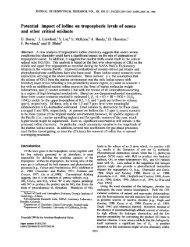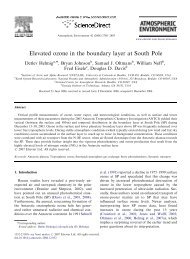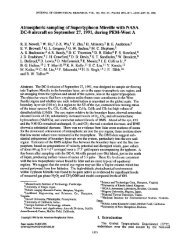A Study of the Chemical Degradation of ClONO2 in the ...
A Study of the Chemical Degradation of ClONO2 in the ...
A Study of the Chemical Degradation of ClONO2 in the ...
You also want an ePaper? Increase the reach of your titles
YUMPU automatically turns print PDFs into web optimized ePapers that Google loves.
Vol. 4, No. 1 Geophysical Research Letters January 1977<br />
A STUDY OF THE CHEMICAL DEGRADATION OF ClONO 2 IN THE STRATOSPHERE<br />
A. R. Ravishankara and D. D. Davis<br />
Eng<strong>in</strong>eer<strong>in</strong>g Experiment Station, Georgia Institute <strong>of</strong> Technology, Atlanta, Georgia 30332<br />
G. Smith and G. Tesi<br />
Department <strong>of</strong> Chemistry, University <strong>of</strong> Maryland, College Park, Maryland 20742<br />
J. Spencer<br />
Chemistry Department, University <strong>of</strong> California, Irv<strong>in</strong>e, California 92664<br />
Abstract. The flash photolysis-resonance<br />
fluorescence technique has been utilized to measure<br />
<strong>the</strong> rate constants for <strong>the</strong> reactions <strong>of</strong><br />
chlor<strong>in</strong>e nitrate (ClONO 2) with two stratospheric<br />
radicals, O(3p) and OH. Both rate constants were<br />
measured at a pressure <strong>of</strong> 20 Torr and a temperature<br />
<strong>of</strong> 245 K. The reactions with <strong>the</strong>ir<br />
correspond<strong>in</strong>g rate constant <strong>in</strong> units <strong>of</strong> cm -3<br />
molecule-Is -1 are: O(3p) + ClONO 2 --Products,<br />
k! = (2.0 ñ 0.2) x 10-13; OH + ClON02 ---<br />
Products, k 2 = (3.7 ñ 0.2) x 10 -13 .<br />
The above results, coupled with <strong>the</strong> photo-<br />
lysis rate <strong>of</strong> ClON02, <strong>in</strong>dicate that <strong>the</strong>se<br />
chemical degradation pathways contribute less<br />
than 10% to <strong>the</strong> removal <strong>of</strong> ClON02 <strong>in</strong> <strong>the</strong><br />
stratosphere.<br />
INTRODUCTION<br />
Recent modell<strong>in</strong>g calculations by Crutzen<br />
(1976), McAfee and Crutzen (1976), Chang and<br />
Wuebbles (1976), and Mol<strong>in</strong>a (1976), have <strong>in</strong>dicated<br />
that stratospheric chlor<strong>in</strong>e nitrate<br />
(ClONO 2) might be <strong>of</strong> importance as a temporary<br />
s<strong>in</strong>k for both chlor<strong>in</strong>e and nitrogen oxides. If<br />
so, <strong>the</strong> impact <strong>of</strong> <strong>in</strong>jected NO x and/or chlor<strong>in</strong>e<br />
on stratospheric ozone pr<strong>of</strong>iles could be<br />
significantly reduced. The effectiveness <strong>of</strong><br />
this potential s<strong>in</strong>k <strong>in</strong> alter<strong>in</strong>g model calculated<br />
stratospheric ozone pr<strong>of</strong>iles depends primarily<br />
on two factors: (1) <strong>the</strong> rate <strong>of</strong> formation, and<br />
(2) <strong>the</strong> rate <strong>of</strong> destruction <strong>of</strong> ClON02. The work<br />
to be reported here deals with <strong>the</strong> rate <strong>of</strong><br />
destruction <strong>of</strong> ClONO 2 under stratospheric conditions.<br />
There are two possible modes <strong>of</strong><br />
destruction <strong>of</strong> ClON02; viz, photolysis by sun<br />
light, and removal by chemical reactions. In <strong>the</strong><br />
latter case, which will be <strong>the</strong> primary focus <strong>of</strong><br />
this paper, likely reaction paths would <strong>in</strong>volve<br />
<strong>the</strong> two free radical species O(3p) and OH, i.e.:<br />
0(3P) + C10N02 __+ Products (1)<br />
OH + ClONO 2 --+Products (2)<br />
Presented <strong>in</strong> <strong>the</strong> follow<strong>in</strong>g text will be recently<br />
measured gas k<strong>in</strong>etic data on Reactions (1) and<br />
(2). Rates <strong>of</strong> destruction via <strong>the</strong> above<br />
processes will <strong>the</strong>n be compared with that resul-<br />
t<strong>in</strong>g from direct photochemical decomposition.<br />
Copyright 1977 by <strong>the</strong> American Geophysical Union.<br />
Paper number 6L0722. 7<br />
EXPERIMENTAL<br />
The flash photolysis-resonance fluorescence<br />
system used <strong>in</strong> this study has been described <strong>in</strong><br />
detail <strong>in</strong> earlier publications (Davis et al.,<br />
1974, 1972). Hence, only a limited description<br />
<strong>of</strong> <strong>the</strong> system is presented here. In this<br />
<strong>in</strong>vestigation a pyrex cell with an <strong>in</strong>ternal<br />
volume <strong>of</strong> 150 cm 3 was used to exam<strong>in</strong>e both<br />
Reactions (1) and (2). The reaction mixture was<br />
ma<strong>in</strong>ta<strong>in</strong>ed at 245 K by circulat<strong>in</strong>g methanol from<br />
a <strong>the</strong>rmostated circulation bath through <strong>the</strong><br />
outer jacket <strong>of</strong> <strong>the</strong> reaction cell. The temperature<br />
<strong>of</strong> <strong>the</strong> cell was monitored us<strong>in</strong>g an Iron-<br />
Constantan <strong>the</strong>rmocouple.<br />
O(3P) was produced by <strong>the</strong> vacuum UV photolysis<br />
<strong>of</strong> 150 m Torr <strong>of</strong> 02 . S<strong>in</strong>ce 20 Torr <strong>of</strong> Ar was<br />
used as <strong>the</strong> diluent gas <strong>in</strong> <strong>the</strong>se experiments, all<br />
O(1D) formed dur<strong>in</strong>g <strong>the</strong> flash would have been<br />
quenched to O(3P) with<strong>in</strong> a few microseconds after<br />
its formation. OH was produced by <strong>the</strong> photolysis<br />
<strong>of</strong> a mixture <strong>of</strong> 25 m Torr <strong>of</strong> 03, 100 m Torr <strong>of</strong> H2,<br />
and 20 Torr <strong>of</strong> Ar through <strong>the</strong> sequence <strong>of</strong> reac-<br />
tions'<br />
03 % h 0(1D ) + 02<br />
O(1D) + H2+ OH + H<br />
H + 03 -+ OH + 02 ß<br />
OH produced <strong>in</strong> <strong>the</strong> last stop would be excited;<br />
however, <strong>the</strong>se radicals would be quenched<br />
to <strong>the</strong>ir ground state with<strong>in</strong> a few microseconds.<br />
The change <strong>in</strong> concentration <strong>of</strong> O(3P) or OH was<br />
followed by <strong>the</strong> resonance fluorescence technique<br />
us<strong>in</strong>g ei<strong>the</strong>r an EIR vacuum UV photomultiplier<br />
tube (1300), or an RCA 8850 tube (3095).<br />
In carry<strong>in</strong>g out experiments on both reactions,<br />
<strong>the</strong> gas handl<strong>in</strong>g system and <strong>the</strong> reaction cell<br />
were "conditioned" by fill<strong>in</strong>g <strong>the</strong>m with chlor<strong>in</strong>e<br />
nitrate at a low pressure (103 ) over <strong>the</strong> concentration<br />
<strong>of</strong> O(3p) or OH; hence, pseudo-first<br />
order k<strong>in</strong>etics prevailed.<br />
Chlor<strong>in</strong>e nitrate was purified by bulb-to-bulb<br />
distillation and its purity was checked by<br />
record<strong>in</strong>g both its IR (Miller et al., 1967), and
8 Ravishankara et al.: <strong>Chemical</strong> <strong>Degradation</strong><br />
3OO i<br />
I00<br />
00(p) + CIONO,<br />
i I I<br />
0 5 I0 15<br />
rntorr <strong>of</strong> ClONO 2<br />
FIGURE 1<br />
A plot <strong>of</strong> <strong>the</strong> pseudo-first order rate constant for<br />
<strong>the</strong> decay <strong>of</strong> OH [O], or O(3p) [O] as a function <strong>of</strong><br />
ClONO<br />
!<br />
ments <strong>of</strong> <strong>the</strong> rate constant kl, and f<strong>in</strong>d<strong>in</strong>g<br />
steadily <strong>in</strong>creas<strong>in</strong>g k 1 values with an <strong>in</strong>crease<br />
<strong>in</strong> <strong>the</strong> residence time. However, at 245 K <strong>the</strong>re<br />
was no evidence for <strong>the</strong> decomposition <strong>of</strong> ClONO 2.<br />
For this reason, both reactions were studied at<br />
<strong>the</strong> reduced temperature <strong>of</strong> 245 K.<br />
Ozone was prepared by pass<strong>in</strong>g 02 through an<br />
ozonator. Before use, 03 was purified by<br />
cont<strong>in</strong>uously pump<strong>in</strong>g while at 195 K; its purity<br />
was checked by UV absorption spectroscopy. UHP<br />
grade Ma<strong>the</strong>son H 2 and 02, and UHP gold label Ar<br />
were used without fur<strong>the</strong>r purification.<br />
RESULTS AND DISCUSSION<br />
The rate constants for both Reactions (1) and<br />
(2) were measured at 245 K simulat<strong>in</strong>g stratospheric<br />
temperatures. The pseudo-first order<br />
rate constants, k' 1 and k2, ' for <strong>the</strong> disappearance<br />
<strong>of</strong> O(3p) and OH are shown as a function <strong>of</strong> <strong>the</strong><br />
ClON02 pressure <strong>in</strong> Figure 1. L<strong>in</strong>ear least square<br />
analyses <strong>of</strong> <strong>the</strong> data were carried out to obta<strong>in</strong><br />
<strong>the</strong> bimolecular rate constants, kbi. At 245 K,<br />
<strong>the</strong> kbi values are<br />
2 pressure at 245 K. The error bars <strong>in</strong> <strong>the</strong>se -13<br />
plots show <strong>the</strong> total uncerta<strong>in</strong>ty observed <strong>in</strong> three kl = (2.0 +.2) x 10<br />
to four <strong>in</strong>dependent measurements <strong>of</strong> <strong>the</strong> first order and<br />
-1 -1<br />
cc molecule sec<br />
rate constant at a given ClONO 2 pressure. k2 = (3.7 +.2) x 10 -13 cc molecule-lsec -1.<br />
UV spectrum. On <strong>the</strong> basis <strong>of</strong> <strong>the</strong>se analyses,<br />
toge<strong>the</strong>r with calculations <strong>of</strong> <strong>the</strong> O(3P) loss due For Reactions (1) and (2), <strong>the</strong> quoted errors are<br />
to <strong>the</strong> reaction, O(3P) + NO 2 --+ NO + 02 (Davis two standard deviations.<br />
et al., 1973), <strong>the</strong> NO 2 impurity level was placed<br />
at less than .5%. It should be noted, however,<br />
In <strong>the</strong> <strong>in</strong>vestigations <strong>of</strong> Reactions (1) and (2)<br />
<strong>the</strong> concentration <strong>of</strong> ClONO 2 (>1014 molecule cm -3)<br />
that at 298 K <strong>the</strong>re was evidence <strong>in</strong>dicat<strong>in</strong>g that was typically a thousand times greater than that<br />
ClONO 2 decomposed <strong>in</strong> <strong>the</strong> glass reaction cell when <strong>of</strong> ei<strong>the</strong>r O(3P) (
een negligible. Support<strong>in</strong>g evidence <strong>of</strong> this<br />
po<strong>in</strong>t <strong>of</strong> view was provided by carry<strong>in</strong>g out sever-<br />
al flash energy variation experiments, typically<br />
a factor <strong>of</strong> four, and f<strong>in</strong>d<strong>in</strong>g that <strong>the</strong> pseudo-<br />
first order rate constants kl and k were<br />
<strong>in</strong>dependent <strong>of</strong> <strong>the</strong> flash <strong>in</strong>tensity. S<strong>in</strong>ce any<br />
secondary reaction would necessarily <strong>in</strong>volve<br />
ei<strong>the</strong>r <strong>the</strong> phot<strong>of</strong>ragments <strong>of</strong> C1ONO 2 or products<br />
<strong>of</strong> Reactions (1) and (2), <strong>the</strong> decay rate <strong>of</strong><br />
O(3p) or OH would be proportional to <strong>the</strong> square<br />
<strong>of</strong> <strong>the</strong> flash energy. As noted above, no such<br />
observation was recorded.<br />
Table I lists <strong>the</strong> relative chemical degradation<br />
rates (R i and R2) as a function <strong>of</strong> altitude<br />
result<strong>in</strong>g from Reactions (1) and (2). The<br />
destruction <strong>of</strong> C1ONO 2 through its reaction with<br />
C1(2p3/2) has not been <strong>in</strong>cluded <strong>in</strong> <strong>the</strong> quoted<br />
total chemical degradation rate because: (1)<br />
Ravishankara et al.: <strong>Chemical</strong> <strong>Degradation</strong> 9<br />
<strong>the</strong> rate constant for <strong>the</strong> reaction <strong>of</strong> C1(2P3s/2)<br />
with C1ONO 2 is only 1 x 10-1cm molecule-! -!<br />
accord<strong>in</strong>g to prelim<strong>in</strong>ary results obta<strong>in</strong>ed <strong>in</strong><br />
ourslaboratory, and (2) <strong>the</strong> concentration <strong>of</strong><br />
Ci(P3/2) at mid-stratospheric altitudes is very<br />
much lower than that <strong>of</strong> ei<strong>the</strong>r OH or O(P).<br />
Along with <strong>the</strong> chemical degradation rates, we<br />
have listed <strong>the</strong> photochemical destruction rate<br />
(J), as well as <strong>the</strong> total degradation rate <strong>of</strong><br />
C1ONO 2 (R! + R 2 + J). As can be seen from <strong>the</strong><br />
Table, chemical processes (1) and (2) contribute<br />
less than 10% to <strong>the</strong> total rate <strong>of</strong> C1ONO 2<br />
destruction at altitudes less than 30 Km. S<strong>in</strong>ce<br />
th concentration <strong>of</strong> C1ONO 2 is calculated to be<br />
near its maximum around 25 Km and drops <strong>of</strong>f<br />
very significantly at higher altitudes, it must<br />
be concluded that <strong>the</strong> photochemical decomposition<br />
<strong>of</strong> C1ONO 2 <strong>in</strong> <strong>the</strong> stratosphere is by far<br />
<strong>the</strong> most important degradation path for this<br />
molecule. It is possible that <strong>the</strong> contribution<br />
<strong>of</strong> <strong>the</strong> chemical degradation rate to <strong>the</strong> total<br />
destruction <strong>of</strong> C1ONO 2 could be different from<br />
our calculations s<strong>in</strong>ce, (a) <strong>the</strong> concentration <strong>of</strong><br />
OH radicals <strong>in</strong> <strong>the</strong> stratosphere is still not well<br />
known, and (b) radicals o<strong>the</strong>r than OH, O(P), or<br />
C!(2p/2) could also degrade C1ONO2 to a signifi-<br />
cant degree. However, we do not expect our basic<br />
conclusion, that photolysis is <strong>the</strong> dom<strong>in</strong>ant mode,<br />
to change.<br />
Acknowledgements. D. D. Davis would like to<br />
acknowledge th f<strong>in</strong>ancial support <strong>of</strong> this work by<br />
<strong>the</strong> National Aeronautics and Space Adm<strong>in</strong>istration.<br />
G. Tesi was on sabbatical leave from <strong>the</strong> National<br />
Science Foundation dur<strong>in</strong>g this project.<br />
References<br />
Chang, J. and D. Wuebbles, "An Analysis <strong>of</strong><br />
Coupled <strong>Chemical</strong> K<strong>in</strong>etics and Transport Models<br />
<strong>of</strong> <strong>the</strong> Stratosphere", Intnl. Ozone Symposium,<br />
Dresden, E. Germany, August 1976.<br />
Crutzen, P.J., Review <strong>of</strong> Atmospheric Chlor<strong>in</strong>e<br />
Chemistry, Intnl. Ozone Symposium, Dresden,<br />
E. Germany, August 1976.<br />
Davis, D.D., R.E. Huie, J.T. Herron, M.J. Kurylo,<br />
and W. Braun, "Absolute Rate Constant for <strong>the</strong><br />
Reaction <strong>of</strong> Atomic Olygen with Ethylene Over<br />
<strong>the</strong> Temperature Range 232-500 K", J. Chem.<br />
Phys., 56, p.4868 (1972).<br />
Davis, D.D., J. Herron, and J. Huie, "Absolute<br />
Rate Constant for <strong>the</strong> Reaction O(3P) + NO 2<br />
--NO + 02 Over <strong>the</strong> Temperature Range 230-<br />
339 K", J. Chem. Phys., 58, p.530 (1973).<br />
Davis, D.D., S. Fischer, and R. Schiff, "Flash<br />
Photolysis Resonance Fluroescence K<strong>in</strong>etics<br />
<strong>Study</strong>: Temperature Dependence <strong>of</strong> <strong>the</strong> Reactions<br />
OH + CO--+ CO 2 + H, and OH + CH4--H20<br />
J. Chem. Phys., 61, p.2213 (1974).<br />
+ CH 3,<br />
Liu, S.C., T.M. Donahue, R. Cicerone, and W.L.<br />
Chameides, "Effects <strong>of</strong> Water Vapor on <strong>the</strong><br />
Destruction <strong>of</strong> Ozone <strong>in</strong> <strong>the</strong> Stratosphere Perturbed<br />
by C1 x or NOx Pollutants", J. Geophys.<br />
Res., 81, pp.3111-3118 (1976).<br />
McAfee, J. and P.J. Crutzen, Modell<strong>in</strong>g Stratospheric<br />
Photochemistry and K<strong>in</strong>etics, The 12th<br />
Informal Conference on Photochemistry, NBS,<br />
U.S.<br />
1976.<br />
Department <strong>of</strong> Commerce, June 28 - July 1,<br />
Miller, R.H., D.L. Bernitt, and I.C. Hisatsune,<br />
"Infrared Spectra <strong>of</strong> Isotopic Halogen Nitrates<br />
Spectrochimica Acta, 23A, p.223 (1967).<br />
Mol<strong>in</strong>a, M.J., Atmospheric Chemistry <strong>of</strong> Chlor<strong>of</strong>luorocarbons,<br />
The 12th Informal Conference<br />
on Photochemistry, NBS, U.S. Department <strong>of</strong><br />
Commerce, June 28 - July 1, 1976.<br />
(Received November 3, 1976;<br />
accepted November 18, 1976. )






